I am using ggplot2 and trying to incorporate a complex expression using paste and expression altogether.
For example, I am trying to show a value of 0.5e-6 as 0.5 micro second and also (5 x 10^-7 seconds) in the y-axis labels.
So far I am able to do either of this, but not both. A minimal working example is given below.
library(ggplot2)
dat <- data.frame(
A = factor(c("O", "O", "P", "P", "Q", "Q", "O", "O", "P", "P", "Q", "Q"), levels=c("O", "O", "P", "P", "Q", "Q","O", "O", "P", "P", "Q", "Q")),
B = factor(c("P-0.1", "P-0.1", "P-0.1", "P-0.1","P-0.1", "P-0.1", "P-0.2", "P-0.2", "P-0.2", "P-0.2", "P-0.2", "P-0.2"), levels = c("P-0.1", "P-0.1", "P-0.1", "P-0.1","P-0.1", "P-0.1", "P-0.2", "P-0.2", "P-0.2", "P-0.2", "P-0.2", "P-0.2")),
X = c( 0, 1, 0, 1, 0, 1, 0, 1, 0, 1, 0, 1),
Y = c(1e-6, 1.5e-6, 1.2e-6, 1.3e-6, 0.9e-6, 1.4e-6, 3.0e-6, 2.0e-6, 3.2e-6, 2.1e-6, 2.7e-6, 1.9e-6)
)
fancy_scientific_text <- function(l) {
# turn in to character string in scientific notation
l <- format(l, scientific = TRUE)
# quote the part before the exponent to keep all the digits
l <- gsub("^(.*)e", "'\\1'e", l)
l <- gsub("e\\+","e",l)
# turn the 'e+' into plotmath format
l <- gsub("e", "%*%10^", l)
# print (l)
l <- gsub("\\'1[\\.0]*\\'\\%\\*\\%", "", l)
l <- gsub("\\'0[\\.0]*\\'\\%\\*\\%10\\^00", "0", l)
return(l)
}
fancy_scientific <- function(l) {
# return this as an expression
parse(text=fancy_scientific_text(l))
}
human_time_format <- function(y){
if (!is.na(y)){
substitute(paste(m, " ", mu, "s", sep=""), list(m=y*1e6))
}
}
human_times <- function(x = NULL, smbl ="sec"){
sapply(x, human_time_format)
}
human_time_format_combined <- function(y){
if (!is.na(y)){
substitute(paste(y_lab, " (", m, " ", mu, "s)", sep=""), list(m=y*1e6, y_lab=fancy_scientific(y)))
}
}
human_times_combined <- function(x = NULL, smbl ="sec"){
sapply(x, human_time_format_combined)
}
p = ggplot(data=dat, aes(x=X, y=Y, colour=A, size=A, shape=A, linetype=A, fill=B, group=interaction(A,B))) + geom_point() + geom_line() + theme_bw()
p = p + geom_point(size=4, alpha=0) + geom_point(size=4, show.legend=FALSE) + guides(shape = guide_legend(nrow=3, byrow = TRUE, keywidth = 1.5, keyheight = 1), colour = guide_legend(override.aes = list(alpha=1)))
p = p + scale_shape_manual(name="", values=c(21,22,23))
p = p + scale_colour_manual(name="", values=c("#005ccc", "#007700", "#56B4E9"))
p = p + scale_linetype_manual(name="", values=c(0,0,1))
p = p + scale_size_manual(name="", values = c(1, 1, 1))
p = p + scale_fill_manual(name = "", values = c("red", "blue"), guide = guide_legend(override.aes = list(shape = 22, size = 5)))
p0 = p + ggtitle("p0")
p1 = p + scale_y_continuous(name = "Y", labels = fancy_scientific) + ggtitle("p1")
p2 = p + scale_y_continuous(name = "Y", labels = human_times) + ggtitle("p2")
p3 = p + scale_y_continuous(name = "Y", labels = human_times_combined) + ggtitle("p3")
p0 is the unformatted version. p1 is a version with scientific format, p2 is a version with metric unit format, and p3 is the intended format which have both p1 and p2's format. But I could not capture the scientific format here.

